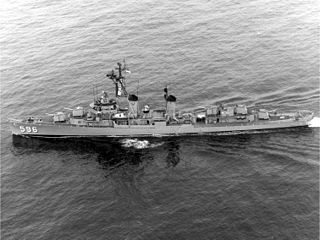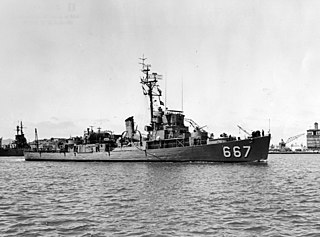
USS Arnold J. Isbell (DD-869), a Gearing-class destroyer, was the only ship of the United States Navy to be named for Arnold J. Isbell, an aircraft carrier captain during World War II. The ship was laid down on 14 March 1945 at Staten Island, New York, by Bethlehem Mariners Harbor, launched on 6 August 1945 and commissioned on 5 January 1946. Constructed too late to see action in World War II, the vessel initially served as a training ship with the United States Atlantic Fleet, before transferring to the Pacific and deploying to Korea during the Korean War and off the Vietnam coast during the Vietnam War. In 1972 Arnold J. Isbell was made part of the reserve training fleet and in 1974, sold to Greece where the ship was renamed Satchouris and served with the Hellenic Navy until being sold for scrap in 2002.

USS Brinkley Bass (DD-887) was a Gearing-class destroyer in service with the United States Navy from 1945 to 1973. She was then transferred to Brazil where she served as Mariz e Barros (D-26) until 1997. The destroyer was finally sunk as a target in 2000.

USS Abbot (DD-629) was a Fletcher-class destroyer in the service of the United States Navy. She was the second Navy ship named after Commodore Joel Abbot (1793–1855).

USS Abercrombie (DE-343) was a John C. Butler-class destroyer escort in the service of the United States Navy from 1944 to 1946. She was finally sunk as a target in 1968.

USS Agerholm (DD-826) was a Gearing-class destroyer of the United States Navy. She was the only ship named for Harold Crist Agerholm, a Private First Class (Pfc.) in the 2nd Marine Division of the United States Marine Corps. He was killed during the assault on Saipan, and posthumously awarded the Medal of Honor.

USS Shields (DD-596), was a Fletcher-class destroyer of the United States Navy.

USS Albert David (FF-1050) was a Garcia-class destroyer escort, later reclassified as a frigate, in the United States Navy. She was named for Lieutenant Albert David, a Medal of Honor recipient. His was the only Medal of Honor awarded to a member of the Navy in the Atlantic Theater of Operations in World War II. Laid down on 28 April 1964 and commissioned on 19 October 1968, Albert David served in the Pacific, including performing gunfire support operations in Vietnam during the 1970s. She was briefly deployed to the Arabian Sea in September and October 1982. On 18 September 1989 she was leased to the Brazilian Navy, and then sold to Brazil where she served as the destroyer Pará until 12 November 2008 when she was decommissioned and put in reserve. She appears to have been scrapped as of 2015.

USS Edwards (DD-265) was a Clemson-class destroyer in the United States Navy and transferred to the Royal Navy where she served as HMS Buxton (H96) and later in the Royal Canadian Navy during World War II.

USS Zellars (DD-777), was an Allen M. Sumner-class destroyer that served in the United States Navy.

USS O'Brien (DD-725), an Allen M. Sumner-class destroyer, was the fourth ship of the United States Navy to be named after Captain Jeremiah O'Brien and his five brothers, Gideon, John, William, Dennis and Joseph, who captured HMS Margaretta on 12 June 1775 during the American Revolution.

USS Walton (DE-361) was a John C. Butler-class destroyer escort in the United States Navy. It was named after Merrit Cecil Walton, a Marine Corps platoon sergeant with the U.S. 1st Marine Division, who died on Gavutu during the Battle of Guadalcanal and was posthumously awarded the Navy Cross for "extraordinary heroism".

USS Bauer (DE-1025) was a Dealey-class destroyer escort in the United States Navy. She was named for Lieutenant Colonel Harold William Bauer, naval aviator and recipient of the Medal of Honor for extraordinary heroism and conspicuous courage as Commander of Marine Fighting Squadron 212 in the South Pacific between 10 May and 14 November 1942.

USS Henderson (DD-785) was a Gearing-class destroyer of the United States Navy, the second Navy ship of that name, and the first named for United States Marine Corps Major Lofton R. Henderson. The previous Henderson was named for Marine Corps Commandant Archibald Henderson.

USS Bausell (DD-845) was a Gearing-class destroyer in the United States Navy during the Korean War and the Vietnam War. She was named for Marine Corporal Lewis K. Bausell (1924–1944), who was awarded the Medal of Honor posthumously for "conspicuous gallantry" during the Battle of Peleliu.

USS Thaddeus Parker (DE-369) was a John C. Butler-class destroyer escort in service with the United States Navy from 1944 to 1946 and from 1951 to 1967. She was scrapped in 1968.

USS Sturtevant (DE-239) was an Edsall class destroyer escort in service with the United States Navy from 1943 to 1946 and from 1951 to 1960. She was scrapped in 1973.

USS Woodson (DE-359) was a John C. Butler-class destroyer escort acquired by the United States Navy during World War II. The primary purpose of the destroyer escort was to escort and protect ships in convoy, in addition to other tasks as assigned, such as patrol or radar picket.

USS Rolf (DE-362) was a John C. Butler-class destroyer escort in service with the United States Navy from 1944 to 1946. She was scrapped in 1973.

USS Hollis (DE-794/APD-86) was a Buckley-class destroyer escort in service with the United States Navy from 1944 to 1947 and from 1951 to 1956. She was scrapped in 1975.

USS Wiseman (DE-667) was a Buckley-class destroyer escort in service with the United States Navy for several periods between 1944 and 1973. She was scrapped in 1974.




















